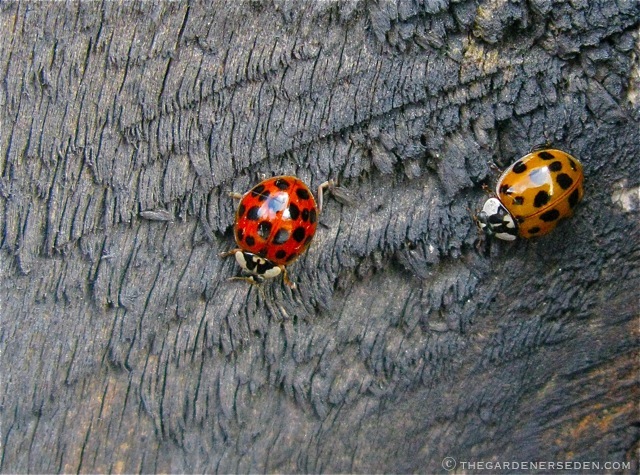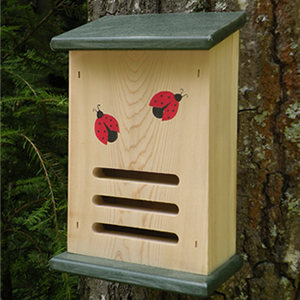Ladybird, Ladybird, Fly Away Home…
 Ladybird beetles seeking shelter in my studio siding for winter’s hibernation
Ladybird beetles seeking shelter in my studio siding for winter’s hibernation
“Ladybird, Ladybird, fly away home. You’re house is on fire, your children have flown”… Oh my goodness, but how that little ditty always freaked me out as a kid. Even now, although I do love it —especially when sung in a hushed and raspy tone— the song can still give me the heebie-jeebies. There are many myths attached to ladybird beetles —or lady bugs if you prefer— and according to one old-wives-tale, if you sing this song, the ladybirds will all fly away. Call me superstitious, but I happen to believe another common ladybird beetle myth… Have you heard that spotting a lady bug is good luck? And if it’s true, boy did I hit the jackpot! Last week, when temperatures rose (to around 60 degrees fahrenheit after the hard frost) ladybird beetles suddenly began filling the air —flying this way and that in the sun— seeking a sheltered place to congregate. Soon, thousands and thousands of lady bugs covered the siding on my studio, where they quickly aggregated in nooks, cracks and crannies. It was quite a colorful spectacle!
Of course ladybird beetles are one of the most familiar beneficial insects, and with the exception of only two harmful Coccinellidae species (the Mexican bean beetle and squash beetle) they always mean good luck for gardeners. There are near 200 species of lady bugs in North America alone, and with both larvae and adults feeding upon garden pests like aphids, mealybugs, scale and spider mites, they are one of the most effective garden-pest predators. I don’t want them to fly away! Please stay right here at my home lady bugs!
 Two of the more common aggregating lady bug species, the convergent and Asian ladybird beetles (Hippodamia convergens and Harmonia axyridis, respectively) seek protection from cold temperatures in both natural and man-made shelters. Some homeowners consider the multicolored Asian ladybird beetle a nuisance, but if the the insects are a problem, they can be collected —gently with a vacuum cleaner—and moved a different location (encourage others to relocate lady bugs by emptying the vacuum in a cool shed, garage or other outbuilding – but not killing them!)
Two of the more common aggregating lady bug species, the convergent and Asian ladybird beetles (Hippodamia convergens and Harmonia axyridis, respectively) seek protection from cold temperatures in both natural and man-made shelters. Some homeowners consider the multicolored Asian ladybird beetle a nuisance, but if the the insects are a problem, they can be collected —gently with a vacuum cleaner—and moved a different location (encourage others to relocate lady bugs by emptying the vacuum in a cool shed, garage or other outbuilding – but not killing them!)
Although lady bug larvae are primarily carnivorous, most species of adult ladybird beetles are omnivores, and also feed upon pollen and other sources of sweet nectar. Throughout the growing season, ladybird beetles are attracted to flower and vegetable gardens, where they feed, mate and lay tiny yellow-orange eggs near food sources (like aphid-infested plants). Beware: lady bug larvae look very different from adult beetles. Immature lady bugs have long, tapered black bodies with yellow or orange markings, (click here to see a photo and previous post on beneficial insects).
During hibernation, lady bugs survive off their own stored body fat. But, if there are indoor pests to consume, they will eat those as well! Active ladybugs require moisture in order to survive. During winter, our houses tend to be hot and dry, and unless they have a source of water, lady bugs often perish. If you enjoy hosting over-wintering lady bugs in your home, be sure to run a humidifier and leave some sources of water available (shallow flowerpot saucers with rocks and a bit of drainage water work splendidly). Once spring arrives, the lady bugs will depart and begin hunting outdoors. Each individual beetle may live approximately two years! You can also make or purchase special, cute houses for lady bug and other beneficial insect-hibernation (including special houses for butterflies and bees).
 Ladybug Hibernation House available at Duncraft
Ladybug Hibernation House available at Duncraft
To learn more about insects —both beneficial and ‘bad bugs’— and how to recognize and manage them, I recommend checking out the following blog posts and books: My post today on Barnes & Noble’s Garden Variety, “Carts of Outdoor Plants Arriving Indoors? Watch Out for Stowaways!”, has a couple of great book recommendations and cultural tips, and further back on Garden Variety, check out “Good Bug or Bad Bug? Let’s See Some ID Please”. Also check here on this blog under the ‘Beneficial Insects’ header and ‘Entomology’ headers on the right side bar for previous articles, like this one on helpful insects, and other useful online resources. You will also find more entomological (the study of insects) book recommendations on the ‘Library’ page at left!
 Ladybird Beetles Seeking Shelter in Numbers in the Siding!
Ladybird Beetles Seeking Shelter in Numbers in the Siding!
***
Article and photographs â“’ 2010 Michaela at TGE
All content on this site, (with noted exceptions), is the property of The Gardener’s Eden and may not be used or reproduced without prior written consent. Inspired by something you see here? Great! Please give credit where credit is due. It’s a small world and link-love makes for fond friendships. Stealing makes for bad dreams…
Do you enjoy visiting The Gardener’s Eden? You can help support this site by shopping through our affiliate links. A small percentage of any sale originating from The Gardener’s Eden will go toward web hosting and maintenance costs. Thank you for your support!
2 Replies to “Ladybird, Ladybird, Fly Away Home…”
Comments are closed.



We live in Canada 1 hour from Montréal. Ours Lady bugs are in hiberantion since couples of weeks. Il love when they are flying all around. I love your Ladybug house I will do one certainely for next year Brillant idea.
If you a have a moment you will welcome to visiting us in http://la-maison-develyne.over-blog.com/article-28479751.html
Thank for your gardener’s Eden beautiful job
Brigitte